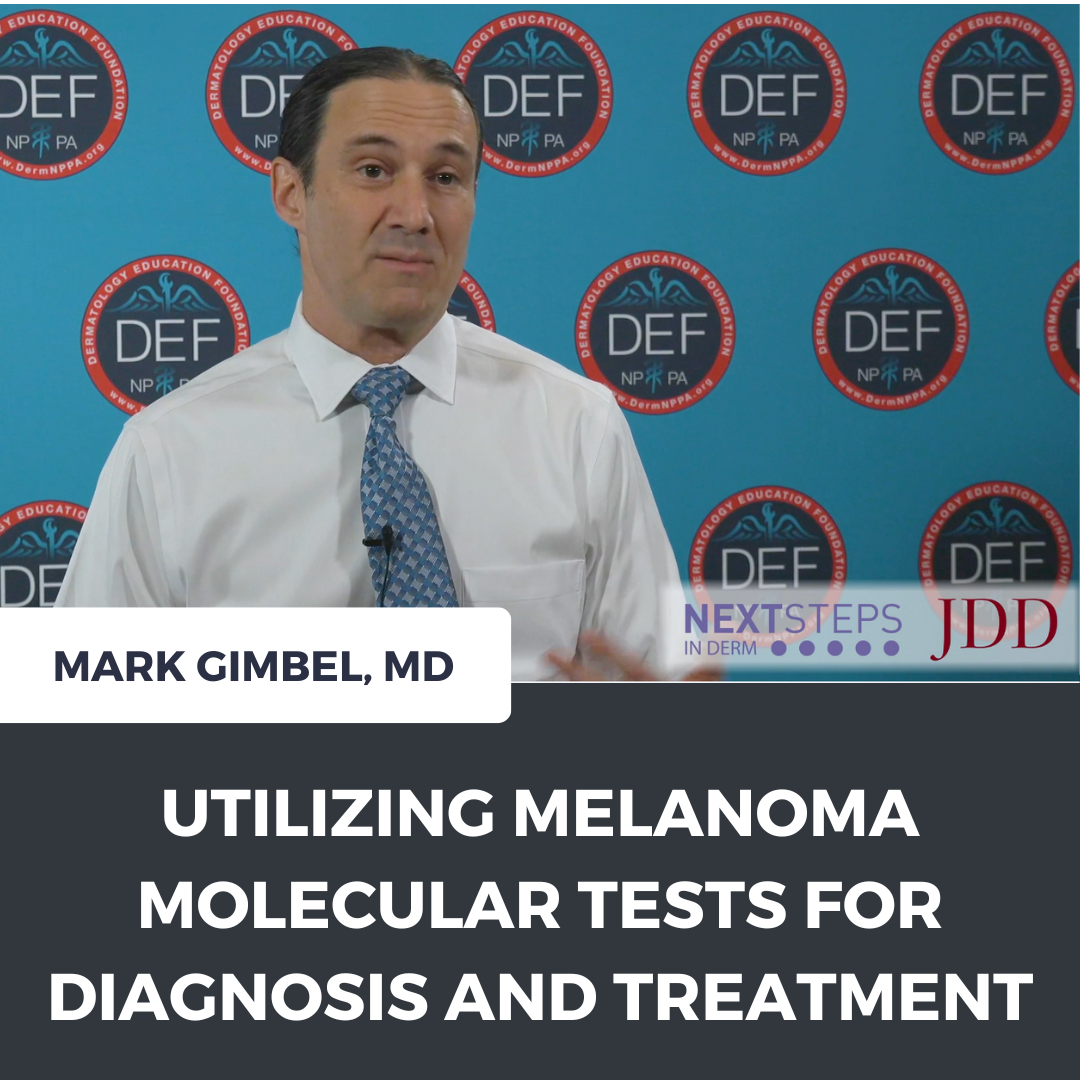Next Steps in Derm and the Journal of Drugs in Dermatology, in partnership with the Dermatology Education Foundation (DEF) and Physicians Resources, interviewed Dr. Mark Gimbel, surgical oncologist with Banner MD Anderson Cancer Center, on how molecular tools are revolutionizing how melanoma is diagnosed, treated and prognosticated. Watch Dr. Gimbel explain the current tests on the market and how to best utilize them. Biology rules, according to Dr. Gimbel, and the days of relying on what is seen in the microscope are over. Learn Dr. Gimbel’s strategies for managing melanoma patients differently in this changing environment.
Dr. Mark Gimbel lectured on this topic at the recent DERM2022 NP/PA CME conference held July 28-31, 2022.
Further Reading
If you want to read more about melanoma testing, check out the following articles published in the Journal of Drugs in Dermatology:
ABSTRACT
Objective: A 31-gene expression profile (31-GEP) test that predicts metastatic risk in patients with cutaneous malignant melanoma (CMM) has previously been validated and is available for clinical use. The test dichotomizes patients into lower risk and higher risk groups based on differences that correspond to unique genetic expression patterns. Although the impact of such a test on dermatology providers’ clinical decision-making has been studied, little is known about whether there exists an association between certain clinical features, such as dermoscopy, and 31-GEP results.
Methods: In this retrospective analysis of 31-GEP test results ordered by dermatologists, we evaluated the frequency of dermoscopic features, using a modified dermoscopy three-point checklist, in 17 cases (n=17) and compared these findings to other key clinicopathologic features including tumor thickness, ulceration, and mitotic rate to 31-GEP results. Additionally, we evaluated the dermatologist’s perspective and incorporation of GEP testing as part of patient discussion on melanoma management.
Results: 31-GEP stratified patients into 4 groups; groups 1A and 1B are considered low risk of metastasis or recurrence, while 2A and 2B are considered high risk. Of the 17 cases, we had fifteen group 1A (88.23%), one 1B (5.88%), and one 2B (5.88%) result. Overall frequency of dermoscopic features is as follows; 100% of lesions presented with asymmetry, 47% with round structures, and 70.6% with blue-white color. The average time providers spent explaining and ordering the test was 15 minutes, with a range of 10 to 20 minutes.
Conclusions: This study represents our experience and understanding of the dermatologist’s role ordering 31-GEP in the care pathway of melanoma patients and we recommend that dermatology providers consider ordering the test for newly diagnosed CMM patients.
ABSTRACT
Introduction: The Pigmented Lesion Assay (PLA) is a non-invasive gene expression test that helps clinicians rule out melanoma via a genomics approach that elevates pigmented lesion management beyond what the eye can see. PLA improves care with a negative predictive value of >99% while reducing biopsies by 90% and while reducing cost.
Methods: The registry study described here (53 US dermatology offices, 90 providers, median patient age 48 years, 60.80% female and 39.20% male patients) assesses real-world utility to determine if the PLA changes clinical practice.
Results: Of 3,418 pigmented skin lesions clinically suspicious for melanoma and assessed by PLA, 324 lesions (9.48%) were PLA(+) and 3,094 (90.52%) were negative. A PLA test result is positive if LINC, PRAME, or both target genes are detected; these molecular pathology findings are known to correspond with histopathology findings of in situ or invasive primary melanoma in 7%, 50%, and 93%, respectively. The 9.48% PLA(+) cases consisted of 5.15% LINC only, 1.93% PRAME only, and 2.40% LINC and PRAME double positive cases. Notably, 97.53% of PLA(+) lesions were surgially biopsied, while 99.94% of PLA(-) cases were clinically monitored and not biopsied.
Discussion: These findings demonstrate that community-based clinicians who employ the PLA to improve pigmented lesion management use the test’s results to guide how they practice. Pigmented lesions with PLA(+) test results are subjected to surgical biopsies, whereas PLA(-) lesions are followed clinically and not biopsied.
Did you enjoy this video interview? Find more here.

